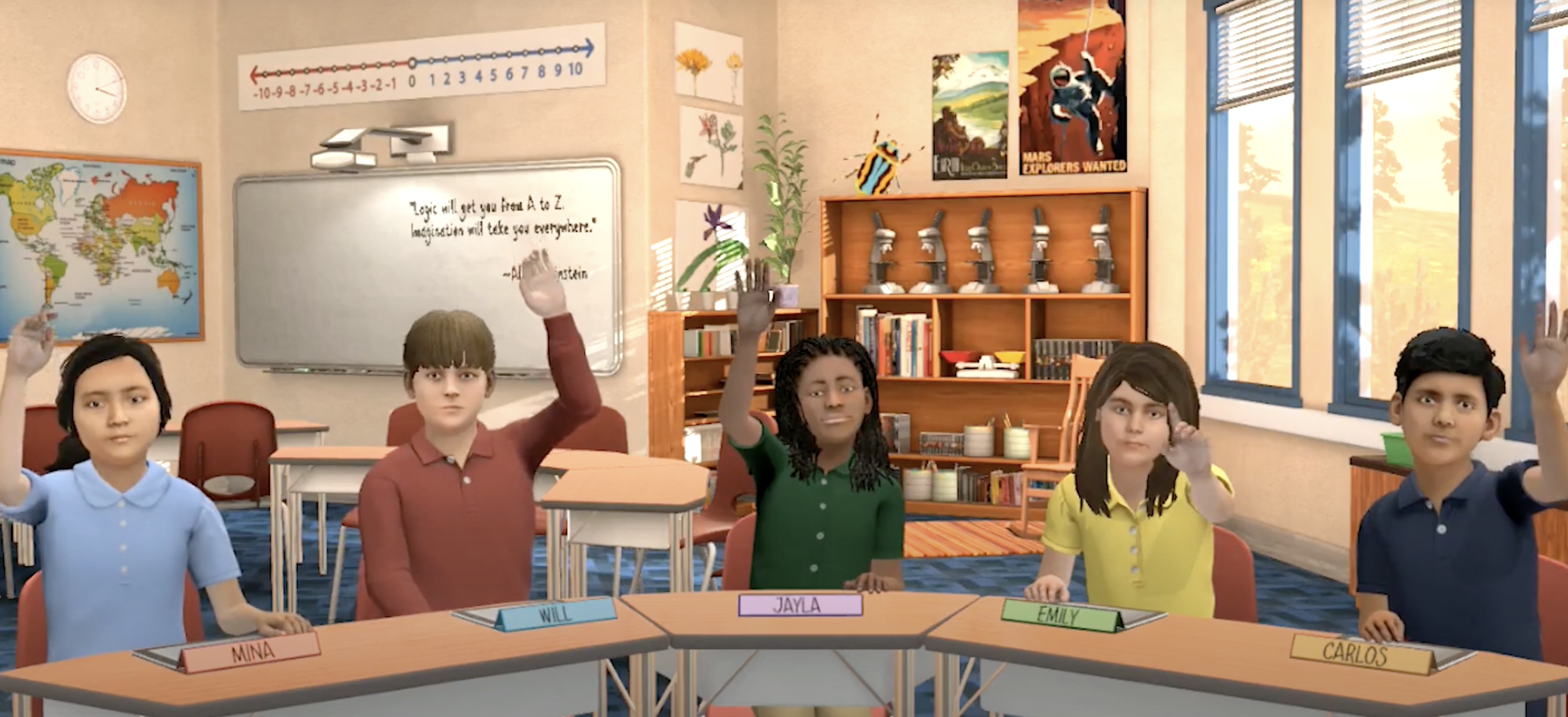Share this Guide
Mixed-Reality Simulation for HLP #6
Definition: Mixed-reality simulation (MRS) is a type of simulated interaction that is gaining popularity in teacher preparation. It is a well-validated approach for candidates in fields outside of education, including the military and medical field (McGaghie, Issenberg, Petrusa, & Scalese, 2010) and has been applied successfully in a small number of studies in education. MRS extends upon traditional role play and allows pre- and in-service teachers to purposefully practice important teaching strategies they are learning about prior to, or alongside, their K-12 field experiences (Driver, Zimmer, & Murphy, 2008). The key difference is that MRS allows for real-time interaction that mimics an authentic classroom setting. Education simulations allow pre-service teachers to practice decision-making and instructional skills in an environment that allows them to see how real K-12 students might respond and adjust their actions based on those responses (Dieker, Hynes, Hughes, & Straub, 2014). Further, the simulations provide meaningful opportunities for instructor and peer coaching and feedback (Zimmer, Driver, & McHatton, 2020). Research on simulated interactions have been shown to yield changes in knowledge and instructional skill (Dawson & Lignugaris-Kraft, 2017; Garland et al., 2012; Storey & Cox, 2015; Vasquez III et al., 2017).
Description: In this practice-based learning opportunity (PLO), teacher candidates gain a deeper understanding of HLP #6: Use student assessment data, analyze instructional practices, and make necessary adjustments that improve student outcomes. Candidates will practice by using assessment data to design and teach one explicit instruction lesson in literacy. This activity comprises two parts. In Part 1, candidates learn to conduct a progress-monitoring assessment. (Stages 1-3 described below). In Part 2, candidates plan and implement a lesson related to data collected during the progress-monitoring phase. (Stages 4-7 described below).
The activities in this PLO are intended to be used in a variety of settings and may be used in their entirety or in specific components based on instructional needs (e.g., integrated in coursework, full-day professional development). Purposeful practice of these strategies can occur in a simulator (e.g., Mursion, TeachLivE) or in a role-play setting.
Context: This PLO can be used at different points in the educator preparation program. Candidates should have sufficient knowledge about lesson planning and explicit teaching to engage successfully in this simulation. In addition, candidates should understand the reading skill of fluency and be familiar with strategies to support this skill development. The PLO is part of a course on assessment. Candidates will analyze an assessment and use it to inform how they plan a targeted, explicit lesson for a learner. This simulation is appropriate for pre-service teacher candidates but could also be used in a professional learning environment for novice teachers.
Stage 1: (Pre-Work) Developing Prerequisite Knowledge About Progress Monitoring
What is this stage about?
In this stage, candidates build prerequisite knowledge needed to perform the assessment analysis task designed to develop understanding of HLP #6. The instructor ensures that candidates understand assessment, data-based decision making, and progress monitoring.
How does the instructor implement this stage?
Step 1: Instructor introduces HLP #6 and explains the assessment cycle.
Step 2: Candidates watch a video on progress monitoring (Resource A). Discuss how this will inform their work in planning targeted lesson plans that improve student outcomes.
Step 3: Candidates complete the IRIS Center Module (Resource B) on progress monitoring in reading.
Step 3.1: Have students work through the Challenge, Initial Thoughts, Perspectives & Resources, and Wrap-Up within the module. Students will practice assessing fluency.
Step 3.2: Have students complete the assessment questions at the end of the IRIS Module and reflect on collecting fluency data: What were your initial take-aways from this practice experience? What goals do you have for yourself as you continue to become more fluent in collecting student data?
Step 4: Candidates deepen knowledge about using student assessment data. Select all or some of the articles provided in the materials and resources section (Resource C). Learners read and complete the chart to support their understanding (Resource D). Discuss and relate their reading to HLP #6.
Materials/Resources needed to implement
Resource A: The following video on progress monitoring may be used to support students in developing an understanding of how to effectively administer and use progress monitoring to inform instruction. See: What are some considerations for progress monitoring?
Resource C: Articles
Bundock, K., O’Keeffe, B. V., Stokes, K., & Kladis, K. (2018). Strategies for minimizing
variability in progress monitoring or oral reading fluency. Teaching Exceptional
Children, 50(5), 273-281.
Datchuk S. M., & Hier, B. O. (2019). Fluency practice: Techniques for building automaticity in
foundational knowledge and skills. Teaching Exceptional Children, 51(6), 424-435.
Lindstrom, E. R., Gesel, S. A., & Lemons, C. J. (2019). Data-based individualization in reading:
Tips for successful implementation. Intervention in School and Clinic, 55(2), 113-119.
Powell, S. R., & Stecker, P. M. (2014). Using data-based individualization to intensify
mathematics intervention for students with disabilities. Teaching Exceptional Children,
46(4), 31-37.
Stage 2: Preparing Stage
What is this stage about?
In this stage, candidates prepare to participate in the simulation. Candidates will review the scenario and analyze the data presented on the student, Harrison. Part of this preparation may include developing knowledge needed to use the Mursion simulator if they are unfamiliar with it.
How does the instructor implement this stage?
Step 1: The instructor provides an overview of the scenario (Resource E).
Step 2: Candidates review Harrison’s Individualized Education Program (IEP; Resource F) and consider specific supports that Harrison would need in an inclusive classroom.
Step 3: Candidates review Harrison’s progress-monitoring data (Resource G). Candidates should note patterns and trends related to his reading fluency. The following questions can guide the analysis:
- What does Harrison’s data tell you?
- What are Harrison’s strengths as indicated in his data?
- In what areas does Harrison need to improve as indicated from the data?
- How could you design a lesson plan to support Harrison in his needs and forward his progress as outlined in his IEP?
Materials/Resources needed to implement
Stage 3: Implementation: Data Collection and Analysis
What is this stage about?
In this stage, candidates practice collecting fluency data by participating in the MRS or role play. If completed as a role play, peers play the role of the student, Harrison, according to the guidance provided in the simulation script.
How does the instructor implement this stage?
Step 1: If using MRS, the instructor schedules the session and provides the full scenario for the lab personnel. If role playing, the instructor prepares the students with the scripts for Harrison (Resource H contains the script for Harrison and the hits and misses for the simulation).
Step 2: Candidates record themselves conducting a one-minute timed reading with Harrison to collect progress-monitoring data on Harrison’s fluency. Distribute the fluency probe (Resource I). Candidates should record that data on the data collection form (Resource J).
Step 3: Candidates review the data collected and compare it to the previously collected data in the full scenario and the previous progress-monitoring data (Resource E and Resource G), noting patterns and trends to inform the planning of a lesson specific to Harrison’s academic need.
Materials/Resources needed to implement
Stage 4: Developing Prerequisite Knowledge About Lesson Planning
What is this stage about?
In this stage, candidates learn about using data to plan a targeted lesson.
How does the instructor implement this stage?
Step 1: The instructor reviews data-based decision making and the components of an effective lesson plan (Resource K is a lesson planning template).
Step 2: The instructor shares an example of a skill-specific fluency lesson. This lesson sample is connected to the student Sidney in the IRIS module. Candidates discuss how the sample lesson addresses the needs of the target student and what the candidates have learned about reading fluency (Resource L).
Step 3: The instructor may use other resources to deepen understanding of planning explicit lessons connected to assessment data (Resource M).
Step 4: The instructor may choose to use Resource N and Resource O to support the teaching of HLP #6.
Materials/Resources needed to implement
Resource K: Lesson Planning Template
Resource L: Sample Fluency Lesson Plan
Resource M: Links to sample lesson plans and activities
- Skill specific (digraphs and suffixes/affixes) lesson plans:
- How to incorporate fluency based instructional activities:
Resource N: This resource may be used to support teacher educators’ understanding of how to evaluate their teaching of evidence-based practices. See Evidence-Based Reading Instruction for Grades K-5.
Resource O: The instructor may choose to share the HLP toolkit, including more information about HLP #6, using the following link: High-Leverage Practices in Georgia | CEEDAR.
Stage 5: Implementation: Lesson Planning
What is this stage about?
In this stage, candidates use the data to plan a lesson.
How does the instructor implement this stage?
Step 1: Candidates reread Harrison’s IEP (Resource F) and data collected from the fluency assessment to consider next steps for a lesson for Harrison.
Step 2: Candidates plan a lesson to address Harrison’s fluency needs using the lesson plan template that includes directions for the candidates (Resource K). A lesson plan rubric is provided for evaluation (Resource P).
Materials/Resources needed to implement
Below are the instructional planning resources candidates can view to support planning their lesson. These may be viewed independently or used during class for whole-class or small-group analysis.
Stage 6: Teach the Lesson
What is this stage about?
In this stage, candidates practice HLP #6 by teaching the lesson to Harrison in MRS or in a role-play scenario in the classroom.
How does the instructor implement this stage?
Step 1: If using MRS, the instructor schedules the session and provides the scenario (Hits and Misses) for the lab personnel (Resource Q). If role playing, the instructor prepares the candidates acting the part of Harrison using the scenario in Resource Q.
Step 2: Candidates record themselves teaching the fluency lesson.
Step 3: Candidates review the data collected from the lesson and compare it to the previously collected data, noting patterns and trends to inform the next steps for Harrison.
Materials/Resources needed to implement
Resource Q: Scenario for simulation specialist (hits and misses), or for candidate playing the part of Harrison if used in a role play situation. Note that the information in Resource Q is not to be shared with the other teacher candidates, only the one playing the avatar or Harrison.
Stage 7: (Post-Work) Reflective Stage
What is this stage about?
In this stage, candidates analyze and reflect on the lesson. Candidates watch the video of themselves teaching and collecting post-assessment data on Harrison and compare with the data collected during the simulation as well as Harrison’s previously collected data.
How does the instructor implement this stage?
The instructor directs candidates to analyze and reflect on their videos. The instructor may place candidates in pairs or small groups so they can provide feedback on one another’s videos. We recommend that each candidate have at least one completed Peer Feedback Form to reflect on.
Step 1: The instructor directs candidates to watch the video of themselves teaching the lesson to Harrison and score it using the lesson plan rubric (Resource P).
Step 2: After candidates analyze their video, they complete the post simulation questions (Resource R).
Step 3: Candidates watch a peer’s video and score their lesson plan using the Lesson Plan Rubric (Resource P). They also provide feedback using the Peer Feedback Form (Resource S).
Materials/Resources needed to implement
Full Resource List
Resource A: Progress-monitoring video
Resource B: Iris Center Module
Resource G: Harrison’s PM data
Resource H: Script for Harrison and hits-and-misses document
Resource J: Data Collection Form
Resource K: Lesson Planning Template
Resource L: Sample Fluency Lesson Plan
Resource M: Links to sample lesson plans
Resource N: Evidence-based reading instruction
Resource P: Lesson Plan Rubric
Resource Q: Hits and misses for simulation specialist






